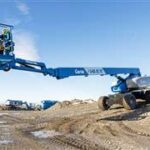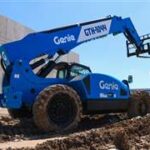Applications of Scissor Lifts
Scissor lifts are used in a wide range of industries and tasks, including:
- Building Maintenance:
- Changing lights, hanging banners, and accessing utilities.
- Ideal for indoor tasks in churches, schools, hospitals, and libraries.
- Portable and easy to move within a building.
- Construction:
- Renovations, general contracting, and other construction projects.
- Adaptable to changing site conditions.
- Delivery and Shipping:
- Lifting heavy cargo to great heights in busy shipping hubs.
- Signage Installation:
- Used by businesses and property managers to install or replace signs.
- Commonly used in workshops, storage facilities, and parking lots.
- Manufacturing and Production:
- Improving efficiency in food processing, chemical manufacturing, and brick-laying.
- Safely lifting heavy items and reaching high areas.
- Warehousing:
- Maximizing vertical and horizontal storage space.
- Speeding up retrieval processes in warehouses and transportation management.
Benefits of Scissor Lifts
Scissor lifts offer numerous advantages, making them indispensable in many industries:
- Improved Productivity:
- Adjustable work surfaces reduce cycle times and enhance loading efficiency.
- Reduced Workplace Injuries:
- Minimizes repetitive lifting and strain, lowering the risk of back injuries.
- Enhanced Ergonomics:
- Adjustable heights accommodate different operators, reducing bending and twisting.
- Access to High and Hard-to-Reach Areas:
- Some models can reach up to 32 feet, making them ideal for elevated tasks.
- User-Friendly Design:
- Simple controls reduce operator fatigue and allow for quick training.
- Compact Size:
- Small footprint makes them ideal for confined spaces like warehouses and event venues.
- Customizable Options:
- Can be modified with tilters, turntables, or other features to meet specific needs.
- Cost-Effective:
- Hydraulic lifts require minimal energy, making them efficient and economical.
Disadvantages of Scissor Lifts
While scissor lifts are highly versatile, they do have some limitations:
- Limited Height: Most models can only reach 20 to 50 feet, less than boom lifts.
- Vertical Movement Only: Cannot navigate around obstacles like boom lifts.
Considerations When Choosing Scissor Lifts
When selecting a scissor lift, consider the following factors:
- Lift and Lower Speeds:
- Faster speeds improve productivity but must be balanced with safety.
- Operator Controls:
- Simple and precise controls reduce setup time and operator fatigue.
- Dimensions:
- Ensure the lift fits through doorways and under ceilings. Fold-down guardrails and remote controls add versatility.
- Working Height:
- Calculate the required working height based on the platform height plus the worker’s reach.
- Jobsite Conditions:
- Choose wheel types based on terrain (small wheels for smooth surfaces, larger tires for rough terrain).
- Safety Features:
- Look for tilt warnings, anti-rollback systems, and automatic speed reduction when the platform is raised.
- Weight Capacity:
- Ensure the lift can handle the combined weight of workers, tools, and equipment.
- Platform Size:
- Choose a platform size that accommodates the task. Extension decks can add extra space but may affect stability.
- Terrain Type:
- For uneven or muddy terrain, opt for rough terrain scissor lifts with four-wheel drive.
Common Problems with Scissor Lifts
Scissor lifts may encounter issues that require prompt attention:
- Irreversible Lifting: Caused by damaged travel switches or control handles.
- Weak or Heavy Lifting: Often due to overload or insufficient power supply.
- Natural Dropping: Caused by dirt in the one-way valve or pressure relief valve issues.
- Failure to Descend: Check the down valve, solenoid valve, or speed control valve.
Inspection and Maintenance of Scissor Lifts
Regular inspections and maintenance are crucial for safe and efficient operation:
Daily Inspections:
- Check for leaks, visible damage, and foreign objects.
- Inspect platform gates, scissor arms, and hydraulic fluid levels.
- Ensure manuals are accessible and accessories are in good condition.
Operational Checklist:
- Verify fluid levels, tire condition, steering, brakes, and battery charge.
- Test emergency controls, horns, lights, and backup alarms.
- Ensure safety devices like harnesses are functional.
Structural Checklist:
- Inspect air, electrical, and hydraulic systems.
- Check guardrails, stabilizers, and mechanical fasteners.
Battery Maintenance:
- Keep batteries clean and dry to prevent surface discharge.
- Test battery performance and charging regularly.
- Use advanced monitoring systems to track charge levels and predict maintenance needs.





